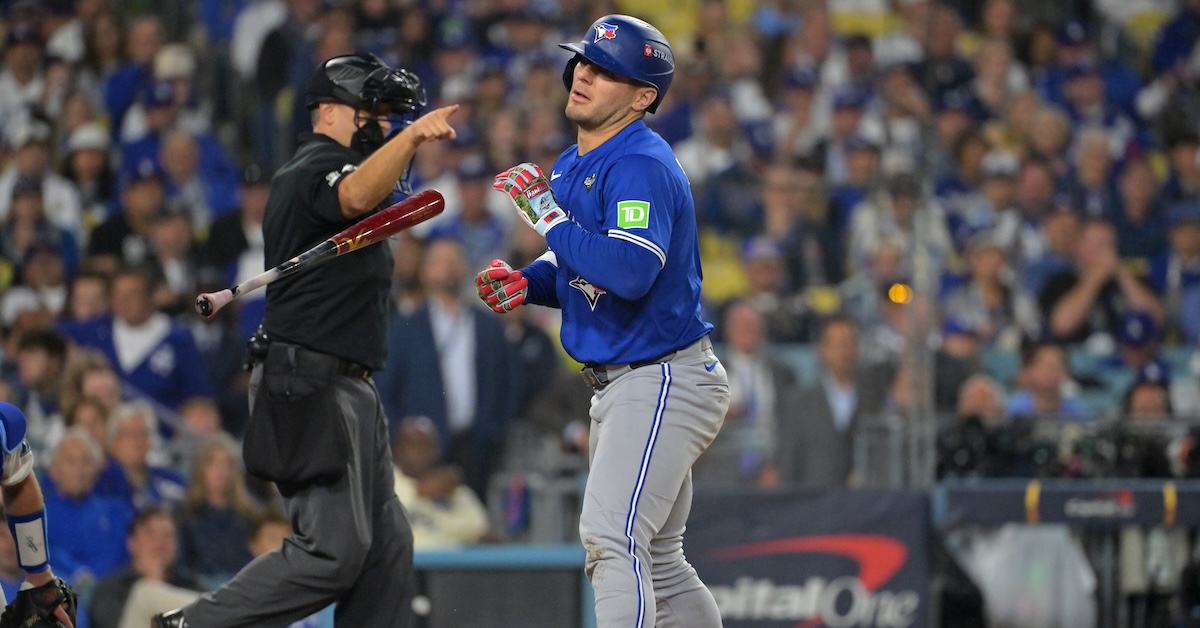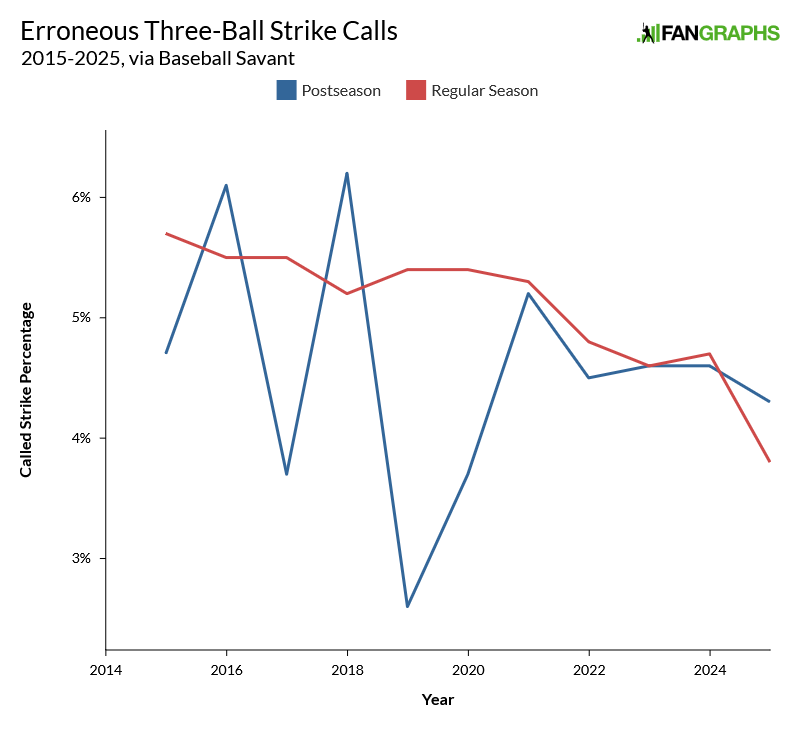Daulton Varsho Runs Afoul of the Bridge Troll Autostrike

I’m going to preface this post with two important caveats. First: Complaining about the fairness of the officiating, in any sport, in any circumstance, is loser behavior. For better or worse, the calls usually even out. And even in the vanishingly rare circumstances where a single call genuinely costs a team a victory, harping on about it isn’t going to change anything.
Second: I’m more lukewarm about the oncoming challenge system, and ABS in general, than a lot of people are. I think the umpires usually do a good job calling balls and strikes, and calling the rulebook zone isn’t going to do much to placate fans who pore over umpire scorecards. They don’t want the rulebook zone; they want their team to get all the calls. Overall, I think it’ll be a positive for the game, I’m just less geeked about it than I was about the pitch clock, for instance.
With all that said, there’s one specific thing I’m looking forward to with the challenge system. It’s going to eliminate my least favorite play in baseball, one we saw with disastrous effect during Game 3 of the World Series, and with any luck for the last time on a major league diamond.
When there’s a three-ball count, if the pitch is at all close to the zone, the home plate umpire waits to see if the batter goes to first base. If he does, only then does the ump call the pitch a strike.
I hate it. It’s worse than your garden variety attention-grabbing ump show behavior; it’s territory-marking. The umpire is reminding the player that wherever the pitch actually went, you can only take your base if I benevolently grant you permission. Going forward, I’ll call this the Bridge Troll Autostrike, because the hitter may not pass until he answers the umpire’s riddles three.
“Least favorite play in baseball” is a big statement, I’ll grant you. I dunno, I guess it’s not as bad as throwing at a batter’s head. But it’s been a special pet peeve of mine for at least 10 years. That’s not an exaggeration. I have receipts. Here are old tweets of mine complaining about the practice in consecutive games of the 2015 Big Ten Tournament. I don’t know who I was complaining to; these 9 a.m. local games had like 100 people in the stands, but there’s a surprise appearance from a young Brandon Lowe. Apparently there was another example during the College World Series, because I still had a bug up my ass about it a month later:
The first law of college baseball is that the umpire cares more about whether you leave for first than whether the ball's in the zone.
— Michael Baumann (@MichaelBaumann) June 25, 2015
Until recently, I considered the Bridge Troll Autostrike to be a distinctly college baseball phenomenon. Umpires down there are generally less skilled and not as rigorously trained, and the NCAA is less able and/or willing to weed out the officious power trippers than is MLB.
But it’s happened a few times in the postseason now. Most notably to Daulton Varsho in the second inning of Game 3, courtesy of home plate umpire Mark Wegner:
Canadian radio & TV calls of the not-Ball Four:
The reason I sound like a lunatic talking about these strike calls is that usually they don’t make a major impact on the game, and so they normally go unnoticed. A guy who gets a bad 3-0 strike call has more chances to reach. Indeed, Varsho did walk eventually, just three pitches later than he should have.
This situation was different for two reasons: First, most Bridge Troll Autostrikes are on genuinely borderline pitches. This one missed the zone by about six inches. In fact, it was higher than the pitch that immediately preceded it, which Wegner called a ball. I try to give umpires as much grace as possible regarding the strike zone, but missing a pitch this badly is just not acceptable at this level.
Second, the call was so egregious, and Wegner’s strike two call was so late and inaudible, that it faked out not only Varsho, but Bo Bichette. Bichette wandered off first, expecting to advance on the walk. Eventually, Tyler Glasnow remembered that the ball was still live and picked him off, stifling a nascent Toronto rally.
If this happened five months from now, Varsho would challenge the call. He’d get his walk and Bichette would be restored to the bases. They’d be made whole, and nobody would be mad about it for more than 30 seconds. But this call had a significant impact on quite an important game, and once it was made, there was no way to correct it.
Heading into Monday night’s game, there had been 18 instances this postseason of a hitter being on the wrong end of a three-ball strike call. As a percentage of opportunities for this call, that’s not outside the historical norm.
I checked on called strikes as a percentage of three-ball pitches outside the strike zone but within four inches of the zone vertically and 3 1/3 inches horizontally. Indeed, umpires have tightened things up over the past few seasons:

And that’s all potential Bridge Troll Autostrike calls. Some of these are honest mistakes or pitches so close to the edge of the zone that the naked eye cannot tell the difference between a ball and a strike.
But of the 18 bad calls before the Varsho-Wegner-Bichette Incident, I could see an argument for as many as 14 or 15 being Bridge Troll Autostrikes. There were a few where the batter obviously disapproved of the call, but did not make a clear move to first base before the umpire made it. ALCS Game 2 had no fewer than four iffy three-ball strike calls (including two on back-to-back pitches to Victor Robles), but they all came late in a blowout. One of the few forces as strong as the Bridge Troll Autostrike is the Please, Let’s All Go Home Autostrike.
I feel comfortable identifying nine pitches from this postseason as potential Bridge Troll Autostrikes, not counting Glasnow-on-Varsho. Here they are, in chronological order.
Brad Keller on Xander Bogaerts, Ninth Inning of Game 3 of the NL Wild Card Series, Home Plate Umpire D.J. Reyburn
A 3-2 pitch in the ninth inning of a close winner-take-all game. Even if you think this was totally innocent — and I have my doubts, given Bogaerts’ run-in with the umpires in Game 1 of this series — it’s a call you can’t miss. Bogaerts, and the Padres, went totally ballistic, and rightly so.
Troy Melton on Jorge Polanco, Fourth Inning of Game 1 of the ALDS, Home Plate Umpire Alex Tosi
Kind of a late call, Polanco well on his way out of the box, 3-0 pitch that sends a message to the hitter without completely screwing up his at-bat — this looks like a textbook Bridge Toll Autostrike. The one bit of exculpatory evidence for Tosi is that Dillon Dingler is a terrific framer, and he yanked the pitch back into the zone.
Colin Rea on Joey Ortiz, Sixth Inning of Game 2 of the NLDS, Home Plate Umpire Mike Estabrook
Ortiz hadn’t made a definitive move toward first when Estabrook pulls the trigger here, but he’d made it clear with his theatrical take that he thought the pitch was inside. And if everyone didn’t get the message the first time, spinning around and talking to himself in obvious disgust made clear his feelings on the call.
Cam Schlittler on Vladimir Guerrero Jr., Fifth Inning of Game 4 of the ALDS, Home Plate Umpire Tony Randazzo
Randazzo definitely rang Guerrero up after he’d started running to first, but Vladito moved very quickly. Plus, it was a terrific framing job by Austin Wells and a very cool pitch by Schlittler. Nobody loves a backdoor sinker for a called strike three more than I do. All that having been said, it was the wrong call, made after the batter had already started to take his base.
Matthew Boyd on Blake Perkins, Fifth Inning of Game 4 of the NLDS, Home Plate Umpire Lance Barksdale
Perkins played this cooler than he needed to. He was already on his way to first, but he calmly stepped back and cocked his head in displeasure. Another great framing job, this one courtesy of Carson Kelly, so I’m not convinced Barksdale was sending a message.
Keider Montero on J.P. Crawford, 12th Inning of Game 5 of the ALDS, Home Plate Umpire Alan Porter
Crawford is the Mike Trout of getting called back from a walk. He was on the wrong end of three of these calls in 12 playoff games this year; he only drew four actual walks the entire postseason.
This would’ve been an absolutely outrageous spot to discipline Crawford for leaving early, and the pitch was both close and well framed by Dingler. But by the time Porter made any movement to call a strike, Crawford had already turned around and bent over, and he was unstrapping his elbow pad by the time Porter actually vocalized his call.
Louis Varland on J.P. Crawford, Seventh Inning of Game 1 of the ALCS, Home Plate Umpire Ryan Additon
Alejandro Kirk is a great framer, but this ball was not even close. This time, Crawford didn’t get as far into the undressing process as he had the game before, but I greatly enjoyed his reaction to the call: A sulky hang like a cat that doesn’t want to be picked up. And rightly so.
Yariel Rodríguez on Leo Rivas, Seventh Inning of Game 2 of the ALCS, Home Plate Umpire Doug Eddings
This was the game I alluded to earlier; with the Mariners up big, Eddings expanded the zone the way you’ll often see late in blowouts. I guess there’s an argument that the umpire shouldn’t do this running clock move in a postseason game, given what we’d learn later about big innings in Blue Jays games, but this doesn’t enrage me like the Bogaerts or Varsho calls did. I only included it here because of how late the call was; Rivas had already spun around and was exiting the batter’s box by the time Eddings’ arm went up.
Kevin Gausman on Jorge Polanco, First Inning of Game 5 of the ALCS, Home Plate Umpire Marvin Hudson
I don’t care how good a framer Kirk is, this was clearly a ball. One way you can tell is from the astonished noises both Joe Davis and John Smoltz made the instant Hudson called this pitch a strike.
At least the Mariners won this game. In the waning days of the Bridge Troll Autostrike, “Ball Don’t Lie” is the best you can hope for.
Michael is a writer at FanGraphs. Previously, he was a staff writer at The Ringer and D1Baseball, and his work has appeared at Grantland, Baseball Prospectus, The Atlantic, ESPN.com, and various ill-remembered Phillies blogs. Follow him on Twitter, if you must, @MichaelBaumann.
I was caught by an umpire trying to pull this off in 13U ball circa 1990. My parents still call it, “Pulling a Jake” when the big leaguers do it.
Not pulling a snake?